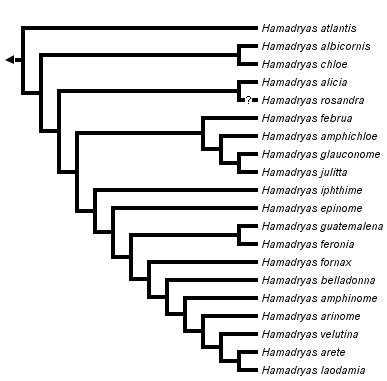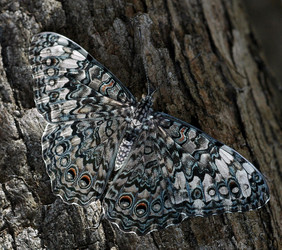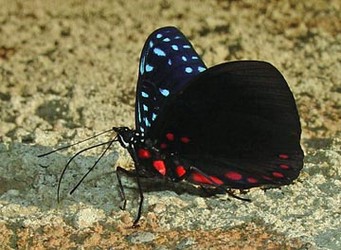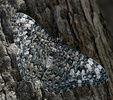Hamadryas
Andrew V. Z. Brower


This tree diagram shows the relationships between several groups of organisms.
The root of the current tree connects the organisms featured in this tree to their containing group and the rest of the Tree of Life. The basal branching point in the tree represents the ancestor of the other groups in the tree. This ancestor diversified over time into several descendent subgroups, which are represented as internal nodes and terminal taxa to the right.

You can click on the root to travel down the Tree of Life all the way to the root of all Life, and you can click on the names of descendent subgroups to travel up the Tree of Life all the way to individual species.
For more information on ToL tree formatting, please see Interpreting the Tree or Classification. To learn more about phylogenetic trees, please visit our Phylogenetic Biology pages.
close boxIntroduction
Members of this neotropical genus perch on tree trunks with their wings pressed flat against the bark. The males of some species make an audible clicking sound in flight, which is the source of their colloquial name "crackers." This feature is lost in some of the derived members of the genus (Garzón-Orduña, 2012).
Discussion of Phylogenetic Relationships
The phylogenetic hypothesis is based on a cladistic analysis of 93 morphological characters using implied weights (Garzón, 2012).References
Garzón-Orduña, I.J. 2012. Phylogenetic evidence for loss of sound production and a shift in sexual recognition signals in Hamadryas butterflies (Nymphalidae: Biblidinae). Systematic Entomology 37, 84-101.
Jenkins, D.W. 1983. Neotropical Nymphalidae I. Revision of Hamadryas. Bull. Allyn Mus. 81, 1-146.
Lamas G ed. 2004. Checklist: Part 4A Hesperioidea - Papiionoidea. Gainesville: Scientific Publishers/Association of Tropical Lepidoptera.
Title Illustrations

| Scientific Name | Hamadryas februa |
|---|---|
| Location | Quintana Roo State, Mexico |
| Specimen Condition | Live Specimen |
| Identified By | Ivonne Garzón-Orduña |
| Life Cycle Stage | adult |
| Source | #2134041 |
| Source Collection | Bugwood Network/Forestry Images |
| Image Use |
 This media file is licensed under the Creative Commons Attribution-NonCommercial License - Version 3.0. This media file is licensed under the Creative Commons Attribution-NonCommercial License - Version 3.0.
|
| Copyright | © William M. Ciesla, Forest Health Management International |
| Scientific Name | Hamadryas laodamia |
|---|---|
| Location | Amazonia Lodge, Atalaya, Peru |
| Specimen Condition | Live Specimen |
| Identified By | Kim Garwood |
| Behavior | puddling on moist sand |
| Sex | Male |
| Life Cycle Stage | adult |
| Source | Starry Night |
| Source Collection | Neotropical Butterflies |
| Copyright | © 2004 Kim Garwood |
About This Page

Middle Tennessee State University, Murfreesboro, Tennessee, USA
Correspondence regarding this page should be directed to Andrew V. Z. Brower at
Page copyright © 2012
 Page: Tree of Life
Hamadryas .
Authored by
Andrew V. Z. Brower.
The TEXT of this page is licensed under the
Creative Commons Attribution License - Version 3.0. Note that images and other media
featured on this page are each governed by their own license, and they may or may not be available
for reuse. Click on an image or a media link to access the media data window, which provides the
relevant licensing information. For the general terms and conditions of ToL material reuse and
redistribution, please see the Tree of Life Copyright
Policies.
Page: Tree of Life
Hamadryas .
Authored by
Andrew V. Z. Brower.
The TEXT of this page is licensed under the
Creative Commons Attribution License - Version 3.0. Note that images and other media
featured on this page are each governed by their own license, and they may or may not be available
for reuse. Click on an image or a media link to access the media data window, which provides the
relevant licensing information. For the general terms and conditions of ToL material reuse and
redistribution, please see the Tree of Life Copyright
Policies.
- First online 06 November 2006
- Content changed 21 April 2012
Citing this page:
Brower, Andrew V. Z. 2012. Hamadryas . Version 21 April 2012 (under construction). http://tolweb.org/Hamadryas/70460/2012.04.21 in The Tree of Life Web Project, http://tolweb.org/









 Go to quick links
Go to quick search
Go to navigation for this section of the ToL site
Go to detailed links for the ToL site
Go to quick links
Go to quick search
Go to navigation for this section of the ToL site
Go to detailed links for the ToL site